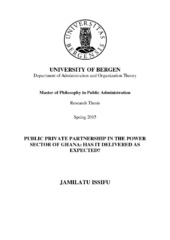| dc.contributor.author | Issifu, Jamilatu | eng |
| dc.date.accessioned | 2015-08-13T06:49:59Z | |
| dc.date.available | 2015-08-13T06:49:59Z | |
| dc.date.issued | 2015-05-31 | |
| dc.date.submitted | 2015-05-31 | eng |
| dc.identifier.uri | https://hdl.handle.net/1956/10268 | |
| dc.description.abstract | The Government of Ghana has made a declaration through the National Energy Policy to attain 5000MW of electricity generation by the end of 2015 in order to meet the 10% annual growth rate of electricity demand. The policy statement emphasised the significant role of the private sector in achieving this objective due to government’s inability to solely finance electricity generation infrastructure. Currently, there are three operational Independent Power Producers (IPPs) who are generating a considerable percentage of electricity being supplied in the country. Of these three, two (Sunon Asogli and CENIT Energy) do not have financial guarantees from the government and have been confronted with the challenge of fuel unavailability and non-payment by their public partner (Electricity Company of Ghana). Since government is unable to solely finance electricity generation infrastructure and because the influx of IPPs has not occurred as envisaged, it becomes imperative that the existing PPPs be effectively managed to ensure further expansion of resources while government continues to seek additional private investment. The main objective of the research was thus to examine the type of working processes between public and private partners and to what extent it influences their effort at attaining the goal of 5000MW power generation capacity. The Theory of Collaborative Advantage by Vangen and Huxham was adopted in the study to examine whether the public and private actors within the present partnership engage in a ‘collaborative’ or ‘exchange’ partnership, which would subsequently determine additional investment in expanding electricity generation facilities in the face of the prevailing challenges. The study adopted a qualitative approach within which there were in-depth discussions with both public and private actors engaged in the PPP projects, which included the primary partners (ECG, Sunon Asogli and CENIT Energy) and the public actors in other governmental institutions who interact with these IPPs and also influence the operations of the partnership. Findings from the study revealed that the integration of private actors in decision making bodies at the national level and the active involvement of governmental actors in addressing challenges of the partnership ensures familiarity with the sector goal and enhances commitment towards its achievement. Irrespective of the commitment demonstrated, the poor relational quality that exists between IPPs actors and their partners at ECG due to ECG’s noncompliance with contractual obligations and exploitation of monopolistic advantage in electricity distribution severs trust and limits the extent to which these IPPs are willing to invest more resources. The goal of attaining 5000MW by 2015 remains overly ambitious because the inflow of private capital has not materialised as anticipated and the current PPPs do not exhibit the collaborative tendencies to guarantee further resource expansion to meet the sector goal. | en_US |
| dc.format.extent | 1996823 bytes | eng |
| dc.format.mimetype | application/pdf | eng |
| dc.language.iso | eng | eng |
| dc.publisher | The University of Bergen | eng |
| dc.rights | Copyright the Author. All rights reserved | eng |
| dc.subject | collaboration | eng |
| dc.subject | independent power producers | eng |
| dc.subject | public private partnership | eng |
| dc.subject | NEP | eng |
| dc.subject | IPP | eng |
| dc.title | Public private partnership in the power sector of Ghana: Has it delivered as expected? | eng |
| dc.type | Master thesis | en_US |
| dc.description.version | publishedVersion | |
| dc.description.degree | Master i Master of Philosophy in Public Administration | |
| dc.description.localcode | AORG351 | |
| dc.description.localcode | MASV-PUBAD | |
| dc.subject.nus | 731111 | eng |
| fs.subjectcode | AORG351 | |
